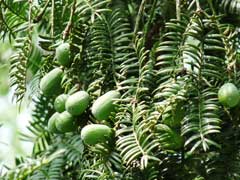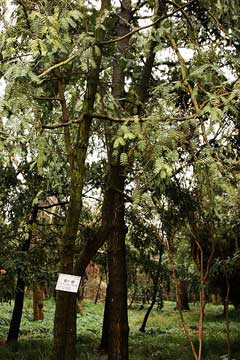 |
|
|
 |
| commons.wikimedia.org/wiki/User:Camphora |
Translate this page:
Summary
Physical Characteristics

 Torreya grandis is an evergreen Tree growing to 25 m (82ft 0in) at a slow rate.
Torreya grandis is an evergreen Tree growing to 25 m (82ft 0in) at a slow rate.
See above for USDA hardiness. It is hardy to UK zone 8. It is in leaf all year, in flower in April, and the seeds ripen from October to November. The species is dioecious (individual flowers are either male or female, but only one sex is to be found on any one plant so both male and female plants must be grown if seed is required). and is pollinated by Wind. The plant is not self-fertile.
Suitable for: light (sandy), medium (loamy) and heavy (clay) soils. Suitable pH: mildly acid, neutral and basic (mildly alkaline) soils. It can grow in full shade (deep woodland) semi-shade (light woodland) or no shade. It prefers moist soil.
UK Hardiness Map
US Hardiness Map
Synonyms
Plant Habitats
Woodland Garden Secondary; Sunny Edge; Dappled Shade; Shady Edge; not Deep Shade;
Edible Uses
Edible Parts: Oil Seed
Edible Uses: Oil
Seed - roasted[46, 61, 63, 105, 183, 266]. An edible oil is obtained from the seed[266].
References More on Edible Uses
Medicinal Uses
Plants For A Future can not take any responsibility for any adverse effects from the use of plants. Always seek advice from a professional before using a plant medicinally.
Anthelmintic Antitussive Carminative Laxative
The flowers are anthelmintic and carminative[218]. The seed is anthelmintic, antitussive, laxative and peptic[218].
References More on Medicinal Uses
The Bookshop: Edible Plant Books
Our Latest books on Perennial Plants For Food Forests and Permaculture Gardens in paperback or digital formats.

Edible Tropical Plants
Food Forest Plants for Hotter Conditions: 250+ Plants For Tropical Food Forests & Permaculture Gardens.
More

Edible Temperate Plants
Plants for Your Food Forest: 500 Plants for Temperate Food Forests & Permaculture Gardens.
More

More Books
PFAF have eight books available in paperback and digital formats. Browse the shop for more information.
Shop Now
Other Uses
Essential Oil Wood
An essential oil is extracted from the aril (fruit)[266]. The wood is used in constructing buildings, bridges, and furniture[266].
Special Uses
Carbon Farming
References More on Other Uses
Cultivation details
Management: Standard Regional Crop Staple Crop: Protein-oil
Succeeds in ordinary garden soil, tolerating some lime[1]. Requires a sheltered position and either high humidity or a moist riverside soil[200]. Dislikes wind exposure[200]. Tolerates woodland shade very well[200]. Requires hot, very humid summers for best growth[200]. This species is not very hardy in Britain, it only succeeds outdoors in the milder areas of the country[1]. It succeeds outdoors at Kew[11], a tree was 8 metres tall in 1970[185]. The seed takes two summers to mature[229]. The edible seed of this very ornamental evergreen tree is often sold in local markets in China. Closely related to T. nucifera[200]. Plants are dioecious so both male and female plants are required if seed is to be produced. Occasional trees are monoecious with dioecious branches.
Carbon Farming
-
Management: Standard
Plants grow to their standard height. Harvest fruit, seeds, or other products. Non-Destructive management systems.
-
Regional Crop
These crops have been domesticated and cultivated regionally but have not been adopted elsewhere and are typically not traded globally, Examples in this broad category include perennial cottons and many nuts and staple fruits.
-
Staple Crop: Protein-oil
(16+ percent protein, 16+ percent oil). Annuals include soybeans, peanuts, sunflower seeds. Perennials include seeds, beans, nuts, and fruits such as almond, Brazil nut, pistachio, walnut, hazel, and safou.
References Carbon Farming Information and Carbon Sequestration Information
Temperature Converter
Type a value in the Celsius field to convert the value to Fahrenheit:
Fahrenheit:
The PFAF Bookshop
Plants For A Future have a number of books available in paperback and digital form. Book titles include Edible Plants, Edible Perennials, Edible Trees,Edible Shrubs, Woodland Gardening, and Temperate Food Forest Plants. Our new book is Food Forest Plants For Hotter Conditions (Tropical and Sub-Tropical).
Shop Now
Plant Propagation
Seed - best sown as soon as it is ripe in a cold frame. Some of the seed should germinate in the following spring though much of it might take another 12 months. Stored seed requires a period of cold stratification and can take 18 months or more to germinate. Prick out the seedlings into individual pots as soon as growth is observed and grow them on in light shade in the greenhouse for at least the next couple of winters, making sure to pot them on into larger pots as and when required. Plant them out into their permanent positions in early summer when the plants are at least 20cm tall. Cuttings of half-ripe shoots in late summer[1]. Cuttings do not grow well[11]. Layering.
Other Names
If available other names are mentioned here
Native Range
TEMPERATE ASIA: China (Anhui Sheng, Fujian Sheng, Hubei Sheng, Jiangsu Sheng, Jiangxi Sheng, Zhejiang Sheng)
Weed Potential
Right plant wrong place. We are currently updating this section.
Please note that a plant may be invasive in one area but may not in your area so it's worth checking.
Conservation Status
IUCN Red List of Threatened Plants Status :

Growth: S = slow M = medium F = fast. Soil: L = light (sandy) M = medium H = heavy (clay). pH: A = acid N = neutral B = basic (alkaline). Shade: F = full shade S = semi-shade N = no shade. Moisture: D = dry M = Moist We = wet Wa = water.
Now available:
Food Forest Plants for Mediterranean Conditions
350+ Perennial Plants For Mediterranean and Drier Food Forests and Permaculture Gardens.
[Paperback and eBook]
This is the third in Plants For A Future's series of plant guides for food forests tailored to
specific climate zones. Following volumes on temperate and tropical ecosystems, this book focuses
on species suited to Mediterranean conditions—regions with hot, dry summers and cool, wet winters,
often facing the added challenge of climate change.
Read More
Expert comment
Author
Fortune. ex Lindl.
Botanical References
11200266
Links / References
For a list of references used on this page please go here
Readers comment
| Add a comment |
|
If you have important information about this plant that may help other users please add a comment or link below. Only comments or links that are felt to be directly relevant to a plant will be included. If you think a comment/link or information contained on this page is inaccurate or misleading we would welcome your feedback at [email protected]. If you have questions about a plant please use the Forum on this website as we do not have the resources to answer questions ourselves.
* Please note: the comments by website users are not necessarily those held by PFAF and may give misleading or inaccurate information.
To leave a comment please Register or login here All comments need to be approved so will not appear immediately.
|
Subject : Torreya grandis
|
|
|
|